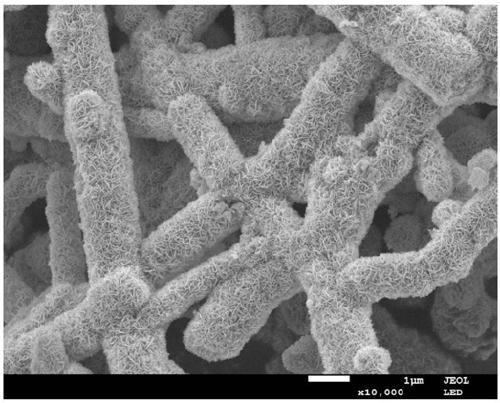Method sed for degrading organic matters with photocatalyst BiOI/BiOBr/CNFs and applications thereof
A photocatalyst and photocatalytic reaction technology, applied in the field of photocatalytic materials, can solve the problems of narrow band gap and low organic matter degradation ability, and achieve high quantum efficiency, broad application prospects, and good visible light photocatalytic degradation of organic matter performance.
- Summary
- Abstract
- Description
- Claims
- Application Information
AI Technical Summary
Problems solved by technology
Method used
Image
Examples
Embodiment 1
[0055] Add 0.48g of bismuth nitrate pentahydrate, 0.0612g of sodium bromide and 0.0664g of potassium iodide to 10mL of ethylene glycol solution, stir well for 20min to a clear solution, then add 60mL of ethanol solution, stir the mixed solution for 30min, add 0.03g of CNFs solution, ultrasonic for 5min Then, it is put into a 1~2MPa autoclave and carries out a constant temperature hydrothermal reaction at 160°C for 12 hours. The product was cooled to room temperature for centrifugal separation, washed with water and ethanol solution 6 times, and dried at 60°C to collect the powder to obtain the final product BiOI / BiOBr / CNFs.
[0056] figure 1 It is the XRD diffraction pattern of the BiOI / BiOBr / CNFs photocatalyst obtained in this example. After comparing with the PDF standard card, it is known that the obtained BiOBr and BiOI are quadrangular phases.
[0057] figure 2 This is a scanning electron micrograph of the BiOI / BiOBr / CNFs photocatalyst obtained in this example, and the obtain...
Embodiment 2
[0063] Add 0.48g of bismuth nitrate pentahydrate, 0.0816g of sodium bromide and 0.0332g of potassium iodide to 10mL of ethylene glycol solution, stir well for 20min to a clear solution and then add 60mL of ethanol solution, stir the mixed solution for 30min, add 0.03g of CNFs solution, ultrasonic for 5min Then, it is put into a 1~2MPa autoclave and carries out a constant temperature hydrothermal reaction at 160°C for 12 hours. The product was cooled to room temperature for centrifugal separation, washed with water and ethanol solution 6 times, and dried at 60°C to collect the powder to obtain the final product BiOI / BiOBr / CNFs.
Embodiment 3
[0065] Add 0.48g of bismuth nitrate pentahydrate, 0.0408g of sodium bromide and 0.0996g of potassium iodide to 10mL of ethylene glycol solution, stir well for 20min to a clear solution and then add 60mL of ethanol solution, stir the mixed solution for 30min, add 0.03g of CNFs solution, ultrasonic for 5min Then, it is put into a 1~2MPa autoclave and carries out a constant temperature hydrothermal reaction at 160°C for 12 hours. The product was cooled to room temperature for centrifugal separation, washed with water and ethanol solution 6 times, and dried at 60°C to collect the powder to obtain the final product BiOI / BiOBr / CNFs.
PUM
| Property | Measurement | Unit |
|---|---|---|
| diameter | aaaaa | aaaaa |
Abstract
Description
Claims
Application Information
 Login to View More
Login to View More - R&D Engineer
- R&D Manager
- IP Professional
- Industry Leading Data Capabilities
- Powerful AI technology
- Patent DNA Extraction
Browse by: Latest US Patents, China's latest patents, Technical Efficacy Thesaurus, Application Domain, Technology Topic, Popular Technical Reports.
© 2024 PatSnap. All rights reserved.Legal|Privacy policy|Modern Slavery Act Transparency Statement|Sitemap|About US| Contact US: help@patsnap.com










